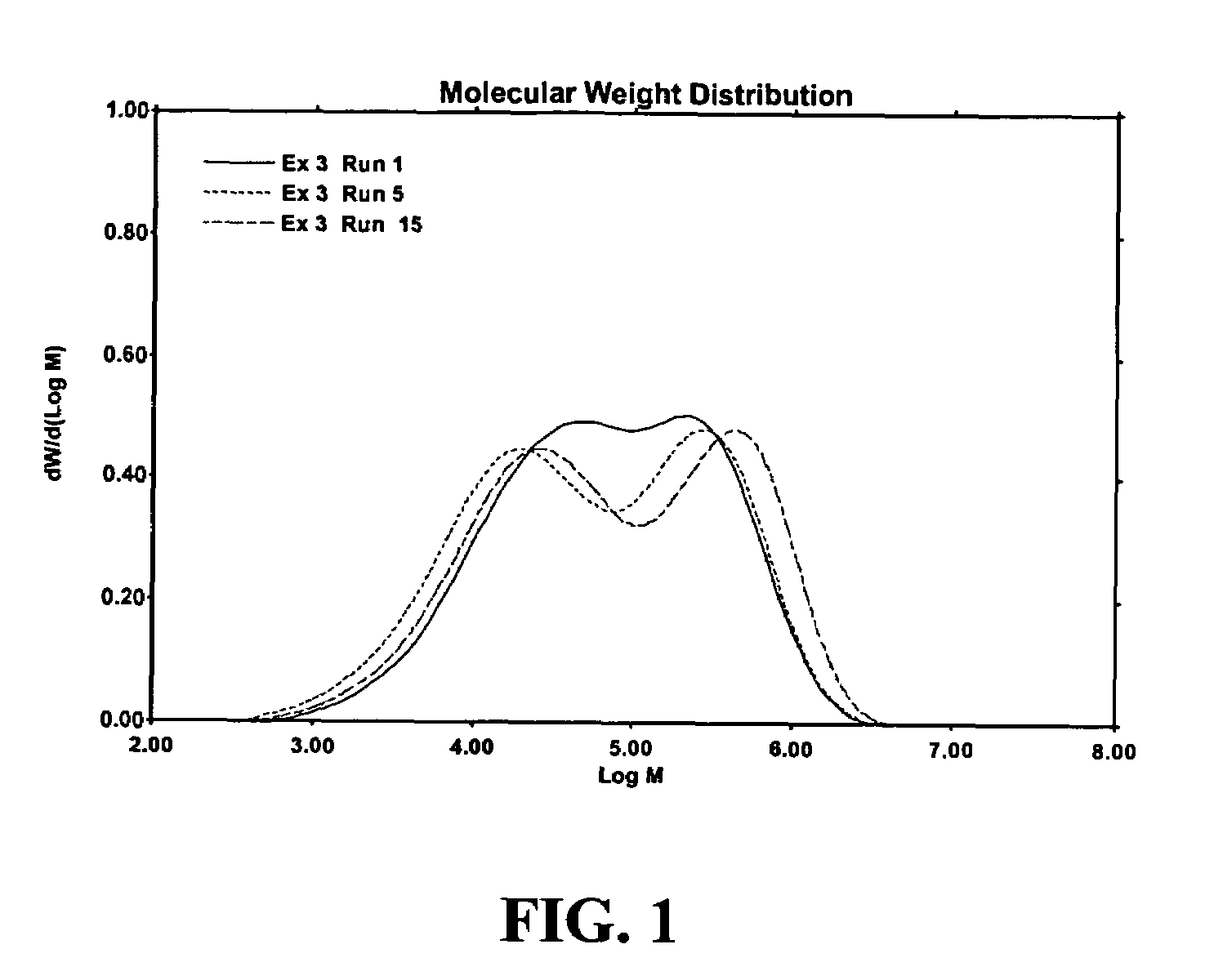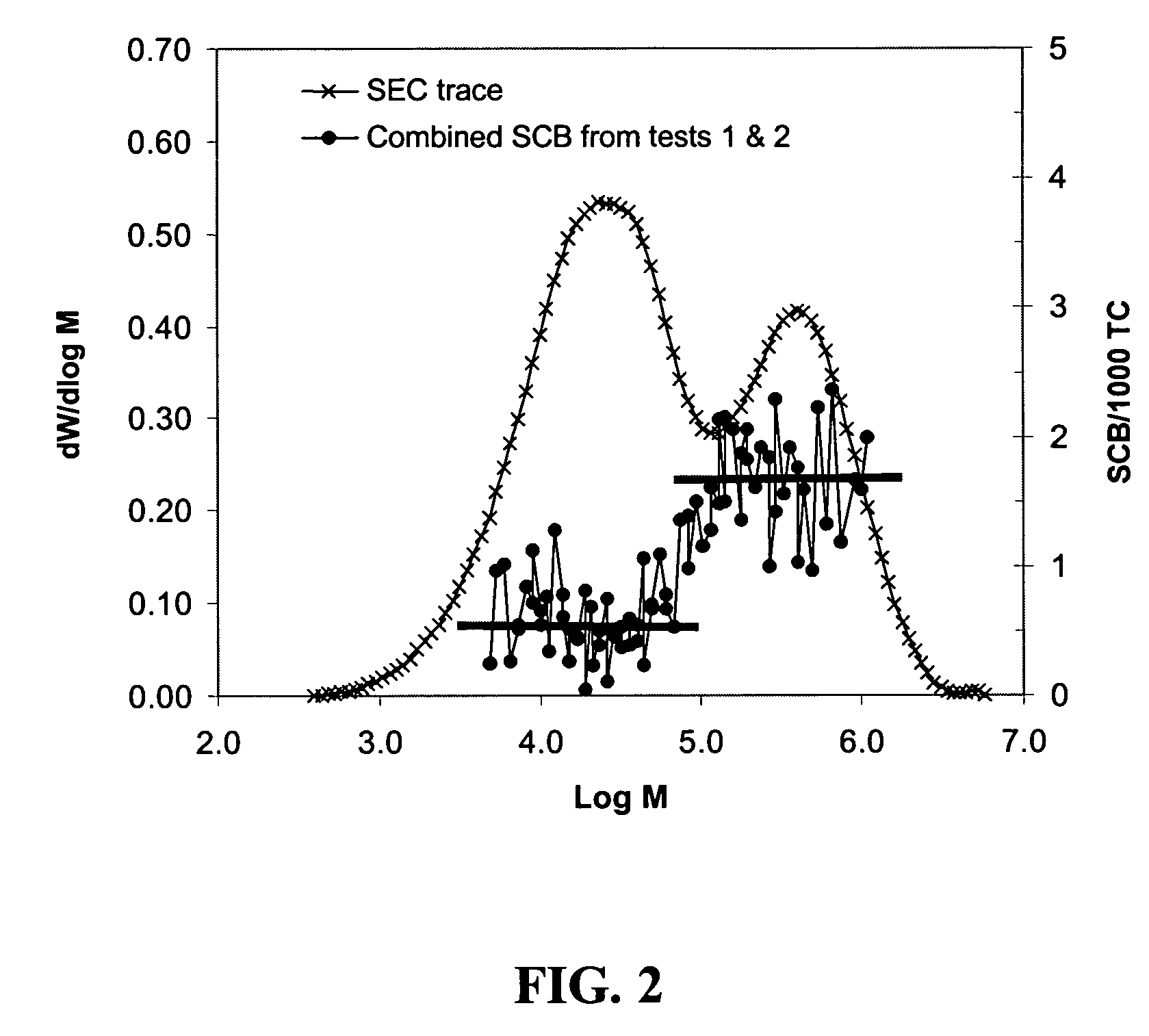Polymerization catalysts and process for producing bimodal polymers in a single reactor
a polymerization catalyst and polymerization technology, applied in the direction of catalyst activation/preparation, physical/chemical process catalysts, chemical/physical processes, etc., can solve the problems of conventional processes not producing items with high stiffness and high escr, and achieve excellent impact strength, excellent stability, and excellent stability.
- Summary
- Abstract
- Description
- Claims
- Application Information
AI Technical Summary
Benefits of technology
Problems solved by technology
Method used
Image
Examples
example 1
Preparation of Sulfated Alumina Activator-Support
[0241]Alumina A, from W.R. Grace Company, was impregnated to incipient wetness with an aqueous solution of ammonium sulfate. Typically, the alumina had a surface area of about 330 m2 / gram and a pore volume of about 1.3 cc / gram. The amount of ammonium sulfate used was equal to 20% of the starting alumina. The volume of water used to dissolve the ammonium sulfate was calculated from the total pore volume of the starting sample (i.e. 2.6 mLs of water for each gram of alumina to be treated). Thus, a solution of about 0.08 grams of ammonium sulfate per mL of water was employed. The resulting wet sand was dried in a vacuum oven overnight at 120° C., and then screened through a 35 mesh screen. Finally, the material was activated in a fluidizing stream of dry air at 550° C. for 3 hours, in the case of bench scale samples, or 6 hours, for the larger pilot plant samples. The samples were then stored under nitrogen.
example 2
Preparation of Metallocene Compounds
[0242]The metallocenes used in the various examples were purchased or prepared as follows. While certain preparations are set forth herein, it should be understood that the metallocenes used in accordance with this invention can be prepared using numerous techniques. Several techniques are described in U.S. patent application Ser. No. 10 / 876,948, “IMPROVED SYNTHESIS OF ANSA-METALLOCENES AND THEIR PARENT LIGANDS IN HIGH YIELD”, incorporated by reference herein in its entirety.
[0243]All manipulations involving air-sensitive reagents and materials were performed under nitrogen by using standard Schlenk line or dry box techniques. The solvent THF was distilled from potassium, while anhydrous diethyl ether, methylene chloride, pentane, and toluene (Fisher Scientific Company) were stored over activated alumina. All solvents were degassed and stored under nitrogen. Zirconium (IV) chloride (99.5%) and n-butyllithium were purchased from Aldrich Chemical Co...
example 3
Preparation of Metallocene Solutions
[0261]Metallocene I: Under nitrogen, 1.00 g of solid metallocene I, bis(indenyl)dichlorozirconium, was slurried in 30 mL of hexene-1, followed by addition of 25 grams of neat (93%) triethylaluminum. This solution was diluted with 200 to 300 grams of n-heptane and transferred to a steel vessel. Isobutane was added to obtain a total of 40 pounds of solution.
[0262]Metallocene B: Under nitrogen, 2.00 g of solid metallocene B, 1-(methyl)-1-(3-butenyl)-1-(cyclopentadienyl)-1-(2,7-di-tert-butylfluorenyl)methane zirconium dichloride, was slurried in 100 to 200 mL of hexene-1, followed by addition of 25 grams of neat (93%) triethylaluminum. This solution was diluted with 160 to 240 grams of n-heptane and transferred to a steel vessel. Isobutane was added to obtain a total of 40 pounds of solution.
[0263]Metallocene C: Under nitrogen, 2.00 g of solid metallocene C, 1-(phenyl)-1-(3-butenyl)-1-(cyclopentadienyl)-1-(2,7-di-tert-butylfluorenyl)methane zirconium ...
PUM
| Property | Measurement | Unit |
|---|---|---|
| polydispersity | aaaaa | aaaaa |
| polydispersity | aaaaa | aaaaa |
| polydispersity | aaaaa | aaaaa |
Abstract
Description
Claims
Application Information
 Login to View More
Login to View More - R&D
- Intellectual Property
- Life Sciences
- Materials
- Tech Scout
- Unparalleled Data Quality
- Higher Quality Content
- 60% Fewer Hallucinations
Browse by: Latest US Patents, China's latest patents, Technical Efficacy Thesaurus, Application Domain, Technology Topic, Popular Technical Reports.
© 2025 PatSnap. All rights reserved.Legal|Privacy policy|Modern Slavery Act Transparency Statement|Sitemap|About US| Contact US: help@patsnap.com



